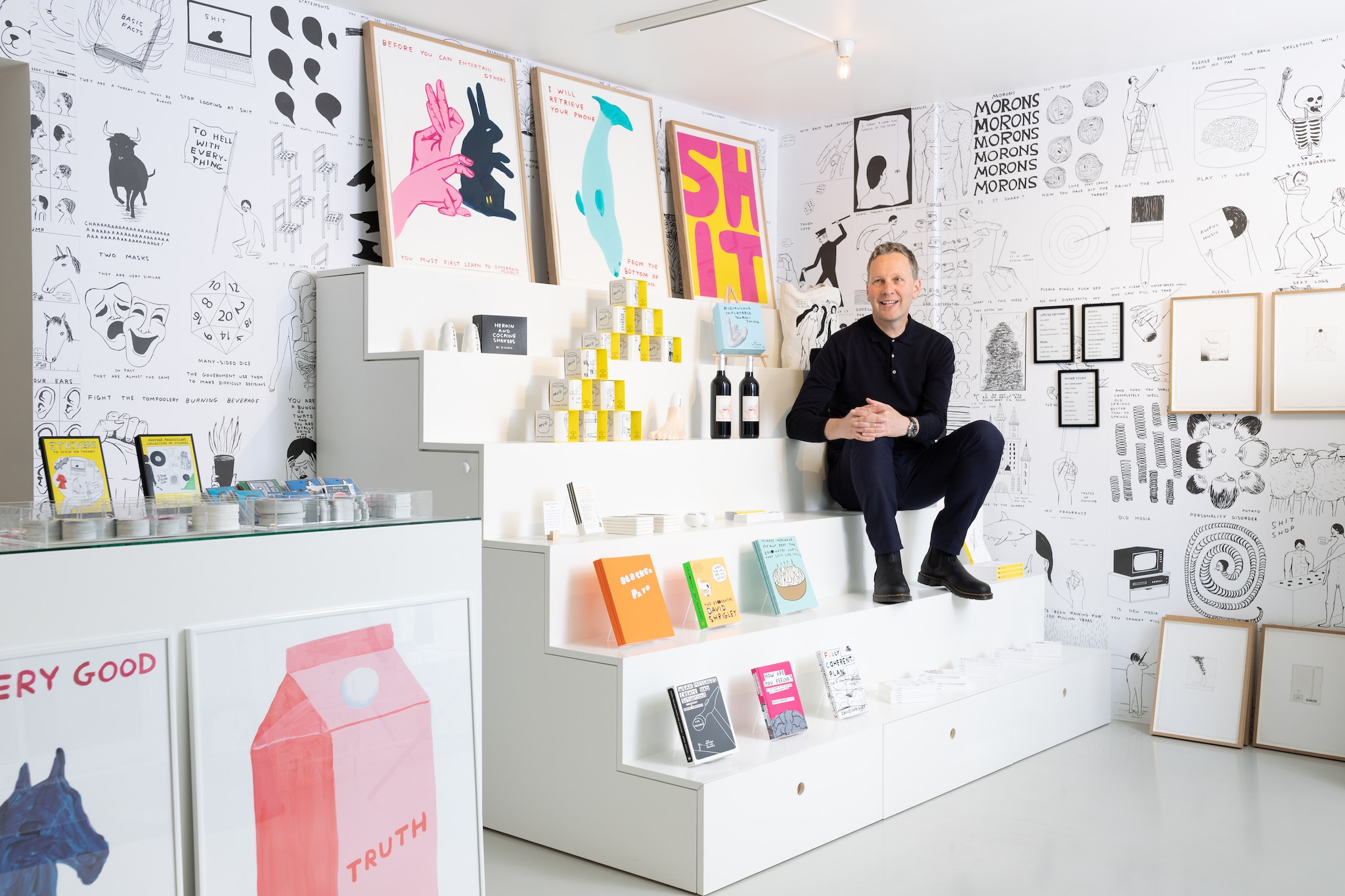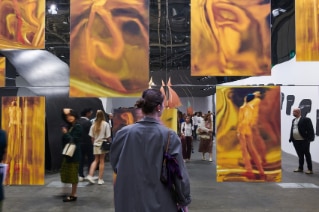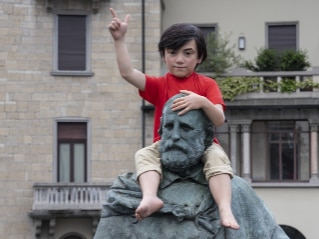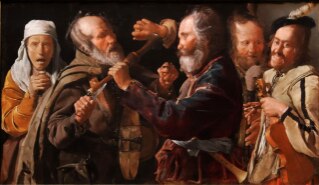by Matteo Pirola
This summer, in three independent sites on the outskirts of Copenhagen – a museum, a kunsthalle, and a gallery – three international artists exhibit their work. The pieces are different and “divergent,” yet they converge in a similar way, thanks to their underlying irony, smile, sarcasm, and disorientation at times, but surely for the provocation and smart reflections behind these contemporary art pieces.
An Icelandic, a Swiss, and a British man (and seen the theme, it might sound like the beginning of a joke) represent a certain type of artistic language over different generations: a great historic master like Roman Signer and two younger but brilliant and already accomplished artists like Ragnar Kjartansson and David Shrigley. They are bright, explosive stars, leading art among themes like the absurd, paradox, and nonsense as a way of finding new meaning.
Through quite peculiar perspectives, these artists teach us that we can see the world even upside-down, which is not that different from what philosophers do after all, who can “imagine” something even in a reverse angle while observing them closeup.
Iceland, Switzerland, and England are three “islands” in their own way, and these artists, born under the northern sky, know how to mix a grey and seemingly dull mood (like ashes covering embers) with actions that often revive colorful and energetic characters. Seen the place we are at – which is often described as heavenly – and playing a bit with words and an Hamletic sounding expression, we could talk about “Damnark”, in order to reevaluate “damnation,” in other words reiterate the change in perspective, in which bliss (not to say a certain idea of beauty) is only a stereotype for a contemporary society that continues to live and go through, over, and beyond crisis.
Ragnar Kjartansson, Louisiana Museum
9 June – 22 OctoberOne of the most beautiful museums, about 40 minutes north of the Danish capital, hosts what is considered the exhibition of the year. Here Ragnar Kjartansson gradually immerges the visitor in a very complex world, made of critique and nostalgia, love and melancholy, identity and disorientation, masculinity and feminism, power and indifference, existentialism and politics, seriousness and smiles, desperation and hope.
Mixing many different types of languages and genres – painting, sculpture, installations, videos, music, theater, performances – and using many points of reference and cross-references to history and contemporary art, the artist openly works with emotions (among which humor and humourism work as ice-breakers) while his work embody – and give a body to – the emotions of these people who take time to learn something about themselves and others.
.jpg)
 View gallery
View gallery
.jpg.foto.rmedium.png)
Ragnar Kjartansson, Epic Waste of Love and Understanding, Louisiana Museum
Photo: Louisiana - Poul Buchard / Brøndum & Co.
.jpg.foto.rmedium.png)
Ragnar Kjartansson, Epic Waste of Love and Understanding, Louisiana Museum
The End - Venezia. Oil on canvas, 144 paintings. Performed at the Icelandic Pavilion during the 53rd Venice Biennale, Italy, 14 June-22 November, daily for six hours.
Fondazione Sandretto Re Rebaudengo, Torino (c) Ragnar Kjartansson. Photo: Louisiana - Poul Buchard / Brøndum & Co.
.jpg.foto.rmedium.png)
Ragnar Kjartansson, Epic Waste of Love and Understanding, Louisiana Museum
Photo: Louisiana - Poul Buchard / Brøndum & Co.
.jpg.foto.rmedium.png)
Ragnar Kjartansson, Epic Waste of Love and Understanding, Louisiana Museum
Photo: Louisiana - Poul Buchard / Brøndum & Co.
.jpg.foto.rmedium.png)
Ragnar Kjartansson, Epic Waste of Love and Understanding, Louisiana Museum
Bangemand (Scaredman), 2023. Performance. Courtesy of the artist, Luhring Augustine, New York, and i8 Gallery, Reykjavik.
(c) Ragnar Kjartansson. Photo: Louisiana - Poul Buchard / Brøndum & Co.
.jpg.foto.rmedium.png)
Ragnar Kjartansson, Epic Waste of Love and Understanding, Louisiana Museum
The End - Venezia, 2009. 144 paintings: oil on canvas, dimensions variable. Performed at the Icelandic Pavilion during the 53rd Venice Biennale, Italy. 14 June to 22 November, daily for six hours. Fondazione Sandretto Re Rebaudengo, Torino. Courtesy of the artist, Luhring Augustine, New York and i8 Gallery, Reykjavik.
Photo: Rafael Pinho © Ragnar Kjartansson
.jpg.foto.rmedium.png)
Ragnar Kjartansson, Epic Waste of Love and Understanding, Louisiana Museum
Photo: Louisiana - Poul Buchard / Brøndum & Co.
.jpg.foto.rmedium.png)
Ragnar Kjartansson, Epic Waste of Love and Understanding, Louisiana Museum
The End - Venezia. Oil on canvas, 144 paintings. Performed at the Icelandic Pavilion during the 53rd Venice Biennale, Italy, 14 June-22 November, daily for six hours.
Fondazione Sandretto Re Rebaudengo, Torino (c) Ragnar Kjartansson. Photo: Louisiana - Poul Buchard / Brøndum & Co.
.jpg.foto.rmedium.png)
Ragnar Kjartansson, Epic Waste of Love and Understanding, Louisiana Museum
Photo: Louisiana - Poul Buchard / Brøndum & Co.
.jpg.foto.rmedium.png)
Ragnar Kjartansson, Epic Waste of Love and Understanding, Louisiana Museum
Photo: Louisiana - Poul Buchard / Brøndum & Co.
.jpg.foto.rmedium.png)
Ragnar Kjartansson, Epic Waste of Love and Understanding, Louisiana Museum
Bangemand (Scaredman), 2023. Performance. Courtesy of the artist, Luhring Augustine, New York, and i8 Gallery, Reykjavik.
(c) Ragnar Kjartansson. Photo: Louisiana - Poul Buchard / Brøndum & Co.
.jpg.foto.rmedium.png)
Ragnar Kjartansson, Epic Waste of Love and Understanding, Louisiana Museum
The End - Venezia, 2009. 144 paintings: oil on canvas, dimensions variable. Performed at the Icelandic Pavilion during the 53rd Venice Biennale, Italy. 14 June to 22 November, daily for six hours. Fondazione Sandretto Re Rebaudengo, Torino. Courtesy of the artist, Luhring Augustine, New York and i8 Gallery, Reykjavik.
Photo: Rafael Pinho © Ragnar Kjartansson
All this is connected by the subtle thread of ambiguity, in between tragedy and comedy. In fact, the artist’s desire is to make the viewer laugh and cry in order to find meaning in tragedies as well, in order to “try to get closer to the void” and turn art into a form of therapy, in which repetition is a method, like a therapeutic mantra said again and again and offered to the visitor in its integrity, until they heal even from the sadness of not having ideas.
The entrance, in the small courtyard the leads into the museum, hosts a large sculpture, a 6-meter classical pedestal made as a deliberately flawed theatrical stenographic element, which reads the inscription and title of the exhibition: “Epic waste of love and understanding.”
This sentence was collected by Kjartasson during a discussion with his wife and perfectly represents the artist’s aptitude, who knows how to stage pieces of private life and make them entrance doors to common emotions but that even relate to great personal, social, historical, or current conflicts. On top of this monolith, there is an almost invisible, small flame, and sometimes a person can be seen walking around the sculpture while singing a heartbreaking melody.
.jpg.foto.rmedium.jpg)
The second piece, the first inside the long entrance hallway, is a series of hundreds of small pedestals/obelisks which are paired salt and pepper shakers which can be distinguished by the words GUILT (salt) and FEAR (pepper), placed on the long hanging shelf. Fear and guilt are here intended as the ingredients that often characterize the “flavor” of a contemporary social life.
Without going into the details of all the pieces, we would like to mention the most striking works, starting from the new installation Me and My Mother, a series of videos in which the artist’s mother spits repeatedly and literally in her son’s face. She does so every five years, and has been doing it for at least twenty, always in the same living room in the artist’s childhood home.
.jpg.foto.rmedium.jpg)
Then, there is an impressive series of 144 portraits, on display as if they were a crowded old painting collection. They were painted by Kjartansson when he participated to the 2009 Venice Biennale (The End - Venice, 2009) to represent the Icelandic pavilion. In the midst of Iceland’s economic and social crisis (caused by a rampant, sexist, and capitalist society), Kjartansson decided to live for 6 months in a palace on the Grand Canal, with an uncompromisingly romantic and nonconformist spirit, spending his days wandering around, drinking, smoking, reading, making music, and painting a silent painting dedicated to the same subject almost every day.
At heart of the exhibition are his video-musical works, in which he takes the time to engage the viewers even through the space of the installations.
Here repetitions, in a sort of positive “repetita juvant”, often become obsessive, with recited or sung sentences which become hypnotic and magnetic.
.jpg.foto.rmedium.jpg)
Then, we find Mercy (2004) in which the artist himself interprets a 1960s singer for one hour, repeating the sentence “Oh why, do I keep hurting you?” and A Lot of Sorrow (2013) for which he asked the American band The Nationals to record for 6 hours their song Sorrow, and lastly the seen, recognized, and awarded absolute masterpiece: The Visitors (2012).
The new pieces are No Tomorrow (2022), set in a hexagonal room made with six big screens that show a perimetrical scene with a visitor in the middle – here a group of musician-dancers move in a musical theater choreography while singing quotes from 1600s French and ancient Greek erotic literature; What have we done to deserve this (2023) is an 11-hour performance set in one of the most special corners of the museum, a small and intimate panoramic room like a domestic living room, in which there is a screen that shows a scene of Scandinavian bourgeois life in that same place using two common and repeated clichés of that society, which thinks that “Every day is a rare gift” while at the same time wonders “What have we done to deserve this?”
.jpg.foto.rmedium.jpg)
Halfway through the hypogeal labyrinth of video spaces, at the top of a staircase (that goes up) in the passage between halls, there is the new and unforeseen live performance Bangemand (Danish tiles which means “Scared Man”), where a handsome and elegant man wearing a smoking with a flower in his lapel shuffling, insecure and scared – shoulders touching the wall – on a think ledge with no way out. This is a clear reference to Hollywood and its cliché, but also to the representation of a man which is a perfect model yet passive and useless, which is perhaps a self-portrait before the artworld.
Outside, in the beautiful garden of Louisiana, among pavilions overlooking the North Sea, on the rooftop of a panoramic restaurant, there is a huge red luminous sign that says, “Scandinavian Pain.” Once again, this piece creates a great creative contrast with the term Hygge, for example, the Scandinavian feeling of impeccable calm.
Roman Signer, Malmö Konsthall
3 June – 10 SeptemberIn Sweden, but only 40 minutes from Copenhagen, the Malmö Konsthall celebrates one of the main representatives of conceptual art and process art. Roman Signer has been a pioneer in the definition of a new language that seed artwork in motion, beyond kinetic art, as an artifice in which time is linked to space, to the objects within it and to the human bodies in relation to them; it is not linked just the artifact. Works in which something moves and in which perhaps nothing happens, or in which everything happens.
His works are considered “temporal” sculptures (different from temporary), in which the sculpting process is made performative and installative, with works lasting a few seconds or a few minutes and are almost always documented with photos and videos that keep the memory alive.
.jpg)
 View gallery
View gallery
.jpg.foto.rmedium.png)
Roman Signer, Malmö Konsthall
Roman Signer, Wasserinstallation, 1999. Water Installation, Stainless steel, kayak, water. Courtesy Bonnefanten Maastricht, collection Bonnefanten
Photo: Helene Toresdotter
.jpg.foto.rmedium.png)
Roman Signer, Malmö Konsthall
Roman Signer, Vier Kajaks, 2023. Four Kayaks. Courtesy the artist
Photo: Helene Toresdotter
.jpg.foto.rmedium.png)
Roman Signer, Malmö Konsthall
Roman Signer. Piaggio, 2013. Courtesy the artist
Photo: Helene Toresdotter
.jpg.foto.rmedium.png)
Roman Signer, Malmö Konsthall
Roman Signer, Haus mit Raketen, 2013. House with Rockets. Photography Courtesy the artist.
Photo: Tomasz Rogowiec
.jpg.foto.rmedium.png)
Roman Signer, Malmö Konsthall
Roman Signer, Haus mit Raketen, 2013. House with Rockets, Plywood, gunpowder. Courtesy the artist
Photo: Helene Toresdotter
.jpg.foto.rmedium.png)
Roman Signer, Malmö Konsthall
Roman Signer, Exhibition view Malmö Konsthall 2023. Umbrellas, Exhibition copy
Photo: Helene Toresdotter
.jpg.foto.rmedium.png)
Roman Signer, Malmö Konsthall
Roman Signer, Ski, 2000. Skis. Photography Courtesy the artist.
Photo: Roman Signer
.jpg.foto.rmedium.png)
Roman Signer, Malmö Konsthall
Roman Signer, Wasserstiefel, 1986. Water Boots. Photography Courtesy the artist. Photograph: Marek Rogowiec
Photo: Helene Toresdotter
.jpg.foto.rmedium.png)
Roman Signer, Malmö Konsthall
Roman Signer, Leiter mit Stiefeln, 2023. Ladder with Boots. Metal ladder, rubber boots. Courtesy the artist
Photo: Helene Toresdotter
.jpg.foto.rmedium.png)
Roman Signer, Malmö Konsthall
Roman Signer, Regenschirme, 2010. Umbrellas. Exhibition copy
Photo: Helene Toresdotter
.jpg.foto.rmedium.png)
Roman Signer, Malmö Konsthall
Roman Signer, Wasserinstallation, 1999. Water Installation, Stainless steel, kayak, water. Courtesy Bonnefanten Maastricht, collection Bonnefanten
Photo: Helene Toresdotter
.jpg.foto.rmedium.png)
Roman Signer, Malmö Konsthall
Roman Signer, Vier Kajaks, 2023. Four Kayaks. Courtesy the artist
Photo: Helene Toresdotter
.jpg.foto.rmedium.png)
Roman Signer, Malmö Konsthall
Roman Signer. Piaggio, 2013. Courtesy the artist
Photo: Helene Toresdotter
.jpg.foto.rmedium.png)
Roman Signer, Malmö Konsthall
Roman Signer, Haus mit Raketen, 2013. House with Rockets. Photography Courtesy the artist.
Photo: Tomasz Rogowiec
.jpg.foto.rmedium.png)
Roman Signer, Malmö Konsthall
Roman Signer, Haus mit Raketen, 2013. House with Rockets, Plywood, gunpowder. Courtesy the artist
Photo: Helene Toresdotter
.jpg.foto.rmedium.png)
Roman Signer, Malmö Konsthall
Roman Signer, Exhibition view Malmö Konsthall 2023. Umbrellas, Exhibition copy
Photo: Helene Toresdotter
.jpg.foto.rmedium.png)
Roman Signer, Malmö Konsthall
Roman Signer, Ski, 2000. Skis. Photography Courtesy the artist.
Photo: Roman Signer
.jpg.foto.rmedium.png)
Roman Signer, Malmö Konsthall
Roman Signer, Wasserstiefel, 1986. Water Boots. Photography Courtesy the artist. Photograph: Marek Rogowiec
Photo: Helene Toresdotter
.jpg.foto.rmedium.png)
Roman Signer, Malmö Konsthall
Roman Signer, Leiter mit Stiefeln, 2023. Ladder with Boots. Metal ladder, rubber boots. Courtesy the artist
Photo: Helene Toresdotter
.jpg.foto.rmedium.png)
Roman Signer, Malmö Konsthall
Roman Signer, Regenschirme, 2010. Umbrellas. Exhibition copy
Photo: Helene Toresdotter
To sieze that moment in which something explodes or blooms and changes state, distruction – not only construction – is seen as a creative and design act that investigates physics and matter, gravity, form and function which can be reconsidered and reinterpreted anew each time, in a continuous and uninterrupted process between exploration, experimentation, action, curiosity, naiveté, play, and fun.
Everyday objects (often fetish objects themselves) like buckets, bins, umbrellas, kayaks, bikes, fans, boots, gloves, ladders, tables, chairs, playhouses etc.…together with fire, air, water, and earth are the primary elements that produce an always new energy and therefore new meaning, which is always poised between order and disorder, stillness and motion, Kaos and Kosmos.
20 large works are on display and installed at their best in the rooms of the Kunsthalle and a video room with the rare collection of more than 70 films documenting his sculptural processes over the past 50 years. Outside, four related to weather conditions and the physical properties of water works are installed on the pond of a city park.
The exhibition poster is one of Signer’s masterpieces, Punkt (2006), in which everything is understood in one minute: art, video, performance, expectation, action, fright, disbelief, painting and surprise.
David Shrigley, Shrig Shop
PermanentPart gallery and part pop shop, as an experimental permanent fixed location in the temporary world of contemporary art, inspired by the operation inaugurated by Keith Haring in the mid-1980s to open new doors to a new audience, the unique Shrig Shop, founded by David Shrigley and his gallerist Nicolai Wallner, opened in 2021 in the city center.

 View gallery
View gallery

David Shrigley, Shrig Shop, Tullinsgade 3 DK-1618, Copenhagen, Denmark
Photo: Sofus Graee
.JPG.foto.rmedium.png)
David Shrigley, Shrig Shop, Tullinsgade 3 DK-1618, Copenhagen, Denmark
Photo: Anders Sundberg
.JPG.foto.rmedium.png)
David Shrigley, Shrig Shop, Tullinsgade 3 DK-1618, Copenhagen, Denmark
Photo: Anders Sundberg

David Shrigley, Shrig Shop, Tullinsgade 3 DK-1618, Copenhagen, Denmark
Photo: Sofus Graee
.JPG.foto.rmedium.png)
David Shrigley, Shrig Shop, Tullinsgade 3 DK-1618, Copenhagen, Denmark
Photo: Anders Sundberg
.JPG.foto.rmedium.png)
David Shrigley, Shrig Shop, Tullinsgade 3 DK-1618, Copenhagen, Denmark
Photo: Anders Sundberg
David Shrigley is an artist who always uses illustration and imagination together, playing with edgy humor and irreverent honesty, working primarily with drawing and painting, but also with animation, printmaking, sculpture, and installation, and constantly seeking to expand his audience by operating outside the traditional sphere of art galleries. This special place offers limited editions, prints, art objects, clothing and accessories, furnishings, and other large and small “things” which serve as extensions of his art.
Through his almost elemental but iconic style and his rigorous and methodical practice, Shrigley explores all possible banalities of the everyday life, observing fear and hope, insecurities and absurdities, to always find a message that concisely represents the unity of the universal and natural as a whole and everyone in the particular human condition.
.jpg)
 View gallery
View gallery


.jpg.foto.rmedium.jpg)
.jpg.foto.rmedium.png)
.jpg.foto.rmedium.png)
.jpg.foto.rmedium.png)
.jpg.foto.rmedium.png)
.jpg.foto.rmedium.png)
.jpg.foto.rmedium.png)
.jpg.foto.rmedium.png)
.jpg.foto.rmedium.png)
.jpg.foto.rmedium.png)
.jpg.foto.rmedium.png)
.jpg.foto.rmedium.png)
.jpg.foto.rmedium.png)







